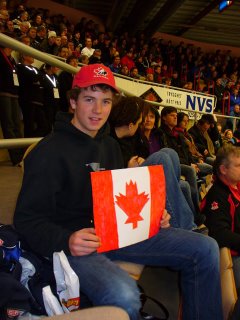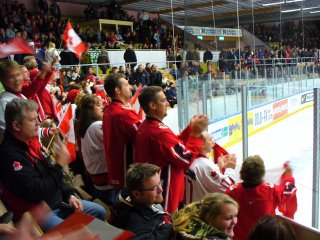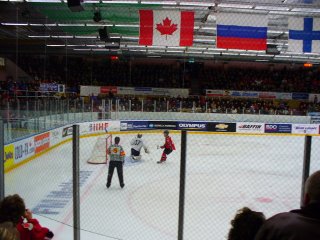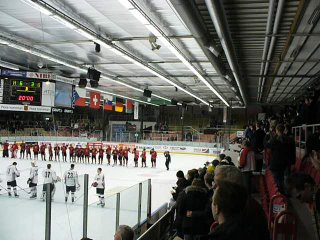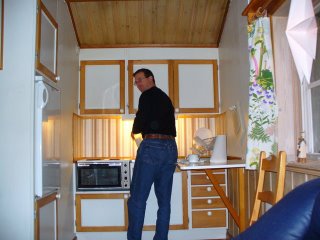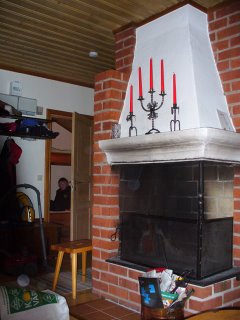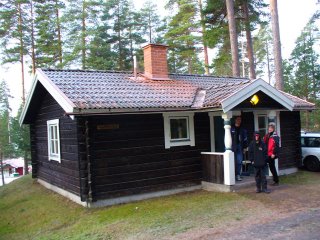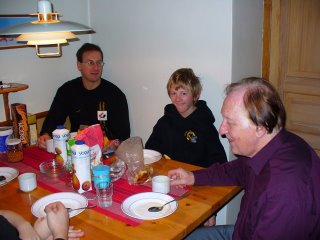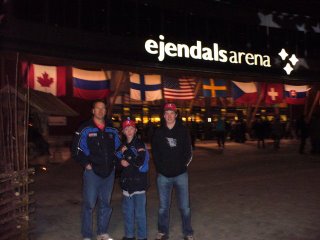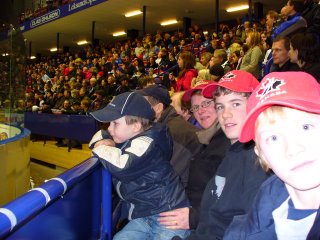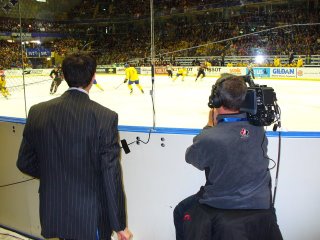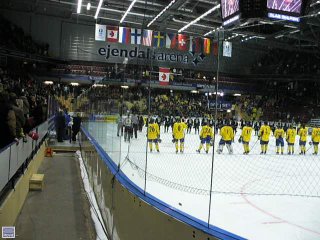We are just past the half way point of the hockey season here in Sunne and I must say hockey in Sweden has been quite enjoyable for all of us. The boys have been able to practice and/or play with more than one team if they want. Hockey is a little more relaxed here with regard to age placement and fund raising requirements. Hockey has essentially been free; no registration fees, no try out fees, no rep fees. The Swedish government pays the organization for each player who particpates. We do have to chip in for a bus when one is used, about 200 Kronar (about $30) for a 2 hour return trip. Luckily the parents of one of the boys owns the local bus company. Teams are responsibe for cafeteria duties and selling programs at games on a rotating basis. For example, H got to work in the cafeteria for one shift during one of the local A-lag (senior team) games and M will sell programs at a game tonight.
Coaching- K has been working with 3 different teams as well as helping out with the school hockey program (from 7-10 icetimes/wk). Coaches here are referred to as trainers and practices are called training. All of the coaches have been super freiendly and accepting of the new English speaking coach from Canada. The coaches have their own office/lounge/locker room where they keep their gear, meet for kaffe (coffee), etc. It is interesting that before each match (game) the home (hem) coaches have a meeting, where they provide kaffe and sweets, with the opposing coaching staff to discuss hockey in general, the game, past games, etc. Scorekeepers and other minor officials are also provided with a tray of kaffe and snacks.
Helmia Arena is owned by the town but sponsored by the local Volvo dealer. Sunne IK (ishockey klubb) pays no ice rental fees but they do pay for the salaries of 1.5 rinkies. This system varies from town to town, for example in the neighbouring town, Munkfors, the ishockey klubb owns the arena. The access to ice time is good in Sunne but it is even better in Munkfors. Another interesting thing is that stinky hockey gear stays at the arena. Each team has a heated, dehunmidified, locked storage room where the players keep their gear in plastic bins/baskets.
 The boys are
The boys are pictured with their gear after practice. As you can imagine it is great to be able to leave your gear at the rink. Their is also a skate sharpening room to which all of the teams have access.
pictured with their gear after practice. As you can imagine it is great to be able to leave your gear at the rink. Their is also a skate sharpening room to which all of the teams have access.
Teams are determined by year of birth generally in one year increments unlike Canada. However, since Sunne is a small town it is difficult to field a team in every age group. So, we have U-16 (A-Pojkar(boys)), U-14 (P-93/94), and U-12 (P-95) teams on which the boys are playing. M plays and practices with the U-16 and U-14 teams, while D plays with the U-12 and practices with the U-14 sometimes. There is definitely no shortage of ice time. M's school is about 100 metres from the arena so he goes to school hockey 1-2 times per week and he is also able to go shoot some pucks at lunchtime. On the other side of the arena is a field house/gymnasium with an indoor soccer field and regular gym. There is also a track next to the school. These areas are called idrottsplats (sports place). Excellent facilities easily accessed by school and community. Many communities are arranged this way in Sweden
Overall, the boys have had fairly successful seasons here in Sunne. They have met new friends, learned some Swedish, travelled around, and had lots of fun by playing hockey for SIK. D's team has some more league games coming up as well as a couple of tournaments to end the season. There are no "provincials" or nationals here in Sweden. M's team is pictured here after winning the silver medal in a "provincial" Varmland tournament. They lost to Färjestad in the final. Färjestad is the equivalent of a select team as they recruit from the surrounding klubbs (a la BWC,NSWC); no residency requirements here. An excellent result for the boys.
They lost to Färjestad in the final. Färjestad is the equivalent of a select team as they recruit from the surrounding klubbs (a la BWC,NSWC); no residency requirements here. An excellent result for the boys.
Another interesting winter sport here is Bandy. It is a combination of hockey, field hockey, and soccer/football. Bandy is played on outdoor ice with a stick that is a cross between a field hockey stick and a hockey stick. There are 10 players and a goalie playing on a huge , soccer field sized, ice surface. Lots of skating, no body checking, larger net than hockey, small ball, quite an interesting game.
Coaching- K has been working with 3 different teams as well as helping out with the school hockey program (from 7-10 icetimes/wk). Coaches here are referred to as trainers and practices are called training. All of the coaches have been super freiendly and accepting of the new English speaking coach from Canada. The coaches have their own office/lounge/locker room where they keep their gear, meet for kaffe (coffee), etc. It is interesting that before each match (game) the home (hem) coaches have a meeting, where they provide kaffe and sweets, with the opposing coaching staff to discuss hockey in general, the game, past games, etc. Scorekeepers and other minor officials are also provided with a tray of kaffe and snacks.

Helmia Arena is owned by the town but sponsored by the local Volvo dealer. Sunne IK (ishockey klubb) pays no ice rental fees but they do pay for the salaries of 1.5 rinkies. This system varies from town to town, for example in the neighbouring town, Munkfors, the ishockey klubb owns the arena. The access to ice time is good in Sunne but it is even better in Munkfors. Another interesting thing is that stinky hockey gear stays at the arena. Each team has a heated, dehunmidified, locked storage room where the players keep their gear in plastic bins/baskets.

 The boys are
The boys are pictured with their gear after practice. As you can imagine it is great to be able to leave your gear at the rink. Their is also a skate sharpening room to which all of the teams have access.
pictured with their gear after practice. As you can imagine it is great to be able to leave your gear at the rink. Their is also a skate sharpening room to which all of the teams have access.Teams are determined by year of birth generally in one year increments unlike Canada. However, since Sunne is a small town it is difficult to field a team in every age group. So, we have U-16 (A-Pojkar(boys)), U-14 (P-93/94), and U-12 (P-95) teams on which the boys are playing. M plays and practices with the U-16 and U-14 teams, while D plays with the U-12 and practices with the U-14 sometimes. There is definitely no shortage of ice time. M's school is about 100 metres from the arena so he goes to school hockey 1-2 times per week and he is also able to go shoot some pucks at lunchtime. On the other side of the arena is a field house/gymnasium with an indoor soccer field and regular gym. There is also a track next to the school. These areas are called idrottsplats (sports place). Excellent facilities easily accessed by school and community. Many communities are arranged this way in Sweden
Overall, the boys have had fairly successful seasons here in Sunne. They have met new friends, learned some Swedish, travelled around, and had lots of fun by playing hockey for SIK. D's team has some more league games coming up as well as a couple of tournaments to end the season. There are no "provincials" or nationals here in Sweden. M's team is pictured here after winning the silver medal in a "provincial" Varmland tournament.
 They lost to Färjestad in the final. Färjestad is the equivalent of a select team as they recruit from the surrounding klubbs (a la BWC,NSWC); no residency requirements here. An excellent result for the boys.
They lost to Färjestad in the final. Färjestad is the equivalent of a select team as they recruit from the surrounding klubbs (a la BWC,NSWC); no residency requirements here. An excellent result for the boys.Another interesting winter sport here is Bandy. It is a combination of hockey, field hockey, and soccer/football. Bandy is played on outdoor ice with a stick that is a cross between a field hockey stick and a hockey stick. There are 10 players and a goalie playing on a huge , soccer field sized, ice surface. Lots of skating, no body checking, larger net than hockey, small ball, quite an interesting game.

Their is also an indoor version, innebandy (like floor hockey) which is played by all of the
kids in and out of school, for fun and competitively.








